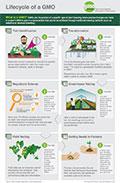Question
Why does most of America not know about GMOs?
Submitted by: wedeservetherighttoknow
Answer
Expert response from Community Manager
Moderator for GMOAnswers.com
Tuesday, 04/08/2015 12:35
GMO Answers was created to do a better job answering questions about GMOs. However, we recognize that the industry has not done the best job in communicating about GMOs – what they are, how they are made, or what the data says. There is a lot of misinformation and it is our goal to make information about GMOs in food and agriculture easier to access and understand. In fact, we went to SXSW this year to talk to people and answer their questions about GMOs directly.
Did you know that GMOs are helping to feed the growing global population? There are a few benefits many people may realize GMOs help provide, such as:
-
Improving Environmental Stewardship – Adapting to challenge conditions. GM drought tolerant corn in the U.S. require less nitrogen, a fertilizer that be costly to farmers and have environmental impacts.
-
Improving Nutrition – Golden rice includes B-Carotene which delivers vitamin A to children in developing nations.
-
Plant Disease Resistance
-
Improved visual appeal to reduce waste – apple varieties that have been enhanced through biotechnology so they do not brown.
Steve Savage, an independent expert, takes an interesting look for consumers on benefits of GMOs in Five Tasty Reasons to Reconsider GMO Crops.
We hope the information provided answers your question. If you have any further questions, please ask. Also, feel free to contribute to the discussion in the comment section below!
Answer
Expert response from Charlie Arnot
CEO of The Center for Food Integrity
Friday, 04/12/2015 09:59
It’s not that most of America doesn’t know about GMOs. It’s what some believe about the technology that sparks the controversy. In a perfect world the social decision-making process would be logical and rational, but it’s more complicated than that. Today’s environment is one in which many factors drive consumer opinions, feelings and beliefs – particularly when it comes to emotion-laden issues like GMOs – and facts are only one element in the decision-making equation. When GMOs were introduced almost two decades ago, both scientific studies and regulatory bodies concluded they were safe, so not much consideration was given to providing additional details to the public. Though unintentional, this lack of on-going communication and transparency eroded consumer trust in GMO technology and the food system in general. As a result, food producers find themselves playing catch up in communicating not just the science of biotechnology, but the social benefits as well.
GMO Innovation Contest Recap!
